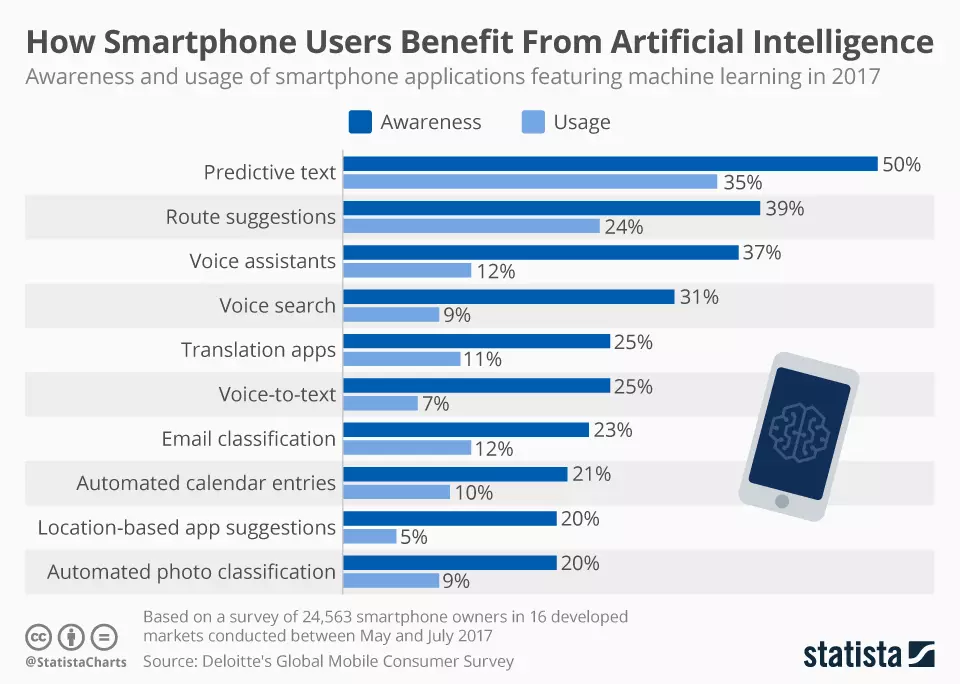How We Use AI in Our Daily Lives
Artificial Intelligence (AI) is the science of making machines intelligent, using algorithms to allow computers to solve problems, which humans only solved in the past. AI technology analyzes vast amounts of data to learn to complete a particular task. This technique is called Machine Learning.
Machine Learning
Machine Learning (ML) allows computer programs to learn and perform a given task all independently without being programmed. In the past, computers could only do what humans programmed them to do. With machine learning, they can behave like humans, gain knowledge and improve based on their past experiences.
The more data the computer programs receive, the more precise its algorithm and predictions become.
Natural Language Processing
Natural Language Processing (NLP) is a branch in AI that gives machines the ability to read, understand human languages and replicate that behavior.
Computers use NLP to look beyond individual words and phrases to understand the context they are being delivered to communicate with anyone in real-time virtually.
AI in Our Everyday Life
Believe it or not, you use AI, ML, and NLP daily, and smartphones are the most extensive channel to bring AI into our lives. On our smartphones, we use multiple applications which AI, ML, and NLP heavily power.
Secure Verification
When you wake up in the morning and want to check your notifications, smart unlock, and verification of smartphones, security systems, and other gadgets, rely on AI, ML, computer vision, and face recognition tech to verify and provide user access.
Intelligent Email Categorization
After unlocking your smartphone with the help of AI, your next step in the morning would probably be to check your email. Almost every email service providing company organizes your inbox using ML algorithms to automatically classify and filter your emails by sender type and categories such as primary, social, promotions, and spam.
Moreover, if you want to compose an email, many email providers use NLP to Accurately predict and suggest sentences for you within the conversation context. Other than predicting and formulating proper sentences, NLP can also correct your spelling mistakes.
Social Media Applications
After responding to your emails, your next step may be to check your social media applications. The information you are getting on your social media accounts is based on your history driven by AI to ensure that your feed meets your preferences.
Another example of an AI-powered social media application is Facebook’s face recognition feature. When you upload a photo on Facebook, the application automatically tags other people in the picture, thanks to its AI/ML-powered face recognition feature.
On another note, Instagram uses AI to detect online bullying in the photos and the comments section. Instagram’s anti-bullying feature uses AI/ML to contextualize the image itself, filter comments, and flag it as harassment. The machine is trained to sort negative comments into different categories such as bullying, racism, and sexual harassment.
Search Engines
If you want to do a quick google search, remember that search engines use AI to complete your search sentence based on your history and preferences. AI personalizes every individual’s search result. It wouldn’t have been possible to search the entire internet in a split second without the help of AI.
Voice Assistance
From scheduling meetings to update weather conditions to making appointments, playing a musical number, AI voice assistants, such as Alexa and Siri, use pattern matching algorithms and NLP to figure out the user intent. Voice assistance can simplify life most effectively and are good at stimulating human conversations.
Camera Applications
Before heading out to work, you may want to post a selfie on your social media platforms. Your camera application runs multiple AI algorithms such as detecting your face and beautify it by smoothing out skin texture or blemished and blurring your background.
AI-powered camera applications also allow face shaping that uses a facial loading algorithm to enhance particular parts of your face, such as making your face thinner and eyes more prominent.
With the help of AI algorithms, your camera can also identify objects in photos and categorize them accordingly.
Commuting and Navigating
Now it’s time to head to work. Whether you are commuting by your car or taking public transportation, AI/ML-powered mobile apps make it simpler. They can estimate the time required to reach your destination, provide you with accurate time traffic alerts, and highlight the different traffic areas. When there is heavy traffic on your daily route, the application will suggest an alternate way.
Cab giants, such as Uber, heavily use AI inside their apps. On-demand fare prices are powered with AI. During peak time, the costs increase because of AI. Also, when you book a shared cab on uber, the application uses AI to decide the sequence of pickup and the shortest path to pick up all the passengers who booked the same shared taxi.
Online Shopping
If you like to shop online, note that the online stores’ recommendations suggest you are driven by AI and are based on your shopping history. The AI also analyzes shoppers who have similar tastes and make intelligent recommendations.
Chatbots
After making an online purchase, you may want to contact customer service. A chatbot is a machine that makes conversation with a human. They are powered with NLP and AI and can essentially handle any question or comment that the customer types in.
Neural networks allow the bot to learn from past conversations and respond to inconsistent statements and continue complex discussions. Because of NLP, they can even understand slang.
Customer support chatbots are fed with thousands of conversation logs to learn which question requires what answer. The bot also uses your order history and account information to understand what you need.
Streaming Services
You are back home from work and want to relax by watching your favorite TV show on your streaming service platform. Streaming services use AI/ML-based recommendation systems to analyze consumer interests and preferences, to make informed and personalized recommendations.
ML algorithm helps streaming companies understand how the products are being used to customize them according to the customer choice on a large scale. Let’s take Netflix, for example. To recommend what you may be most interested in watching next, Netflix has deployed ML algorithms that associate your preferences with that of users with similar tastes.
Also, Netflix asks you to pick some tv shows that you are interested in to fine-tune those recommendations to provide you with a more personalized experience.
Conclusion
To sum it up, smartphone users benefit from AI in many aspects, as the statistics below show.

The possibilities of AI are endless. From Artificial Narrow Intelligence (ANI), Artificial General Intelligence (AGI) to Artificial Super Intelligence (ASI), it is no surprise that AI will power everything to make our lives simpler and more innovative shortly.



